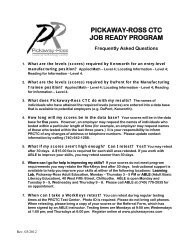Commons
Conceptual Physics - elearning-phys
Conceptual Physics - elearning-phys
- No tags were found...
Create successful ePaper yourself
Turn your PDF publications into a flip-book with our unique Google optimized e-Paper software.
What would have happened if the tape was negatively charged?Answer, p. 182⊲d / Examples of the constructionof atoms: hydrogen (top) andhelium (bottom). On this scale,the electrons’ orbits would be thesize of a college campus.The atom, and subatomic particlesI once had a student whose father had been an electrician. Hetold me that his father had never really believed that an electricalcurrent in a wire could be carried by moving electrons, because thewire was solid, and it seemed to him that physical particles movingthrough it would eventually have drilled so many holes through itthat it would have crumbled. It may sound as though I’m tryingto make fun of the father, but actually he was behaving very muchlike the model of the skeptical scientist: he didn’t want to makehypotheses that seemed more complicated than would be necessaryin order to explain his observations. Physicists before about 1905were in exactly the same situation. They knew all about electricalcircuits, and had even invented radio, but knew absolutely nothingabout subatomic particles. In other words, it hardly ever mattersthat electricity really is made of charged particles, and it hardly evermatters what those particles are. Nevertheless, it may avoid someconfusion to give a brief review of how an atom is put together:charge mass in units of location in atomthe proton’s massproton +e 1 in nucleusneutron 0 1.001 in nucleuselectron −e 1/1836 orbiting nucleusThe symbol e in this table is an abbreviation for 1.60 × 10 −19 C.The physicist Robert Millikan discovered in 1911 that any materialobject (he used oil droplets) would have a charge that was a multipleof this number, and today we interpret that as being a consequenceof the fact that matter is made of atoms, and atoms are made ofparticles whose charges are plus and minus this amount.Electric currente / André Marie Ampère (1775-1836).If the fundamental phenomenon is the motion of charged particles,then how can we define a useful numerical measurement of it?We might describe the flow of a river simply by the velocity of thewater, but velocity will not be appropriate for electrical purposesbecause we need to take into account how much charge the movingparticles have, and in any case there are no practical devices soldat Radio Shack that can tell us the velocity of charged particles.Experiments show that the intensity of various electrical effects isrelated to a different quantity: the number of coulombs of chargethat pass by a certain point per second. By analogy with the flowof water, this quantity is called the electric current, I. Its unitsof coulombs/second are more conveniently abbreviated as amperes,1 A=1 C/s. (In informal speech, one usually says “amps.”)100 Chapter 5 Electricity



